Financial Accounting: Disclosure, Journal Entries, & Tax Worksheet
VerifiedAdded on 2023/06/15
|17
|3684
|68
Homework Assignment
AI Summary
This financial accounting assignment provides a detailed solution covering several key areas. It begins with a letter to the IASB (International Accounting Standards Board) offering recommendations on improving the effectiveness of financial information disclosure, focusing on principles like entity-specific information, clarity, comparability, and appropriate formatting, using Commonwealth Bank and National Australia Bank as examples. The assignment then presents journal entries for Beach Supplies Ltd., detailing transactions related to share issuance, underwriting, and forfeiture. Finally, it includes a worksheet for calculating current tax liability and deferred tax, along with detailed workings for depreciation and expense adjustments.
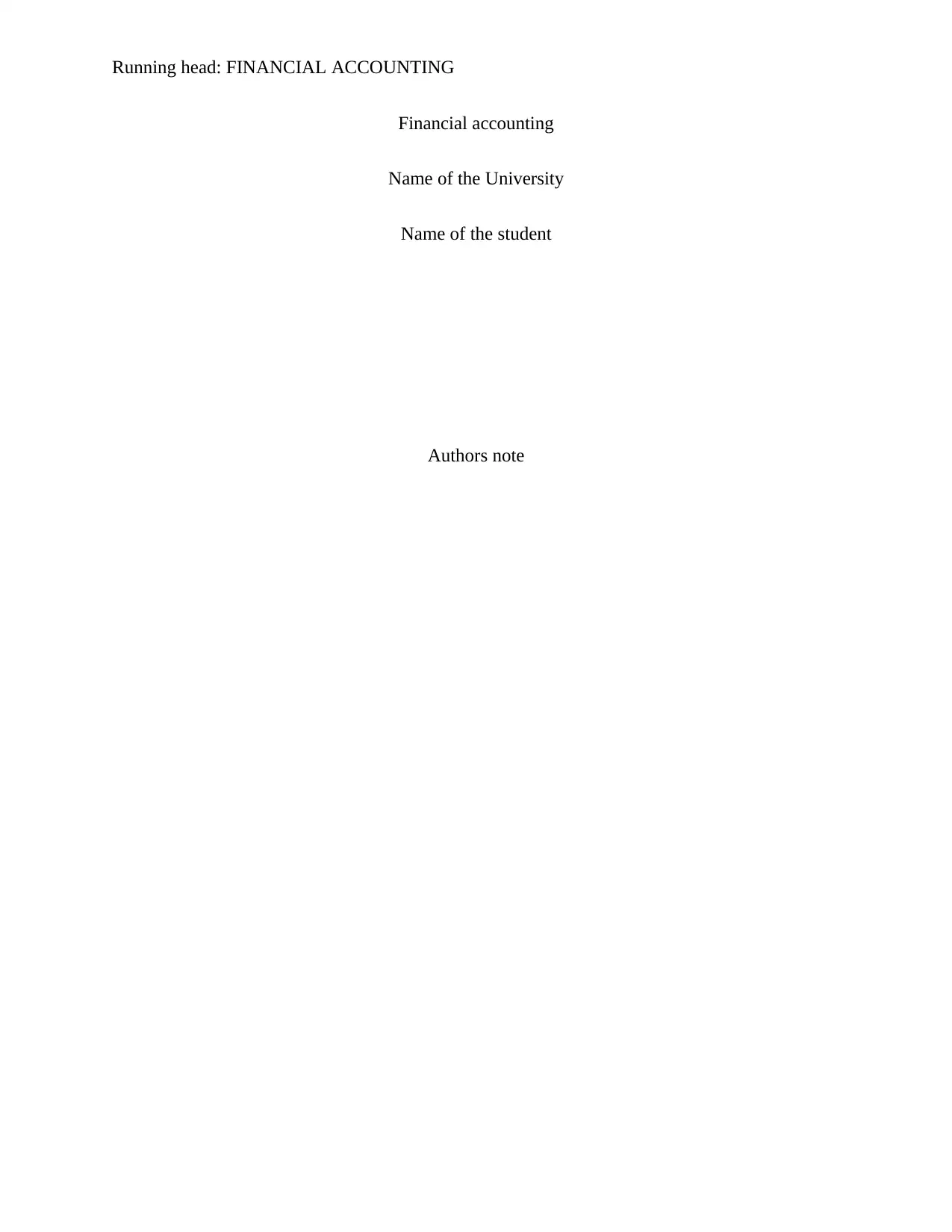
Running head: FINANCIAL ACCOUNTING
Financial accounting
Name of the University
Name of the student
Authors note
Financial accounting
Name of the University
Name of the student
Authors note
Paraphrase This Document
Need a fresh take? Get an instant paraphrase of this document with our AI Paraphraser
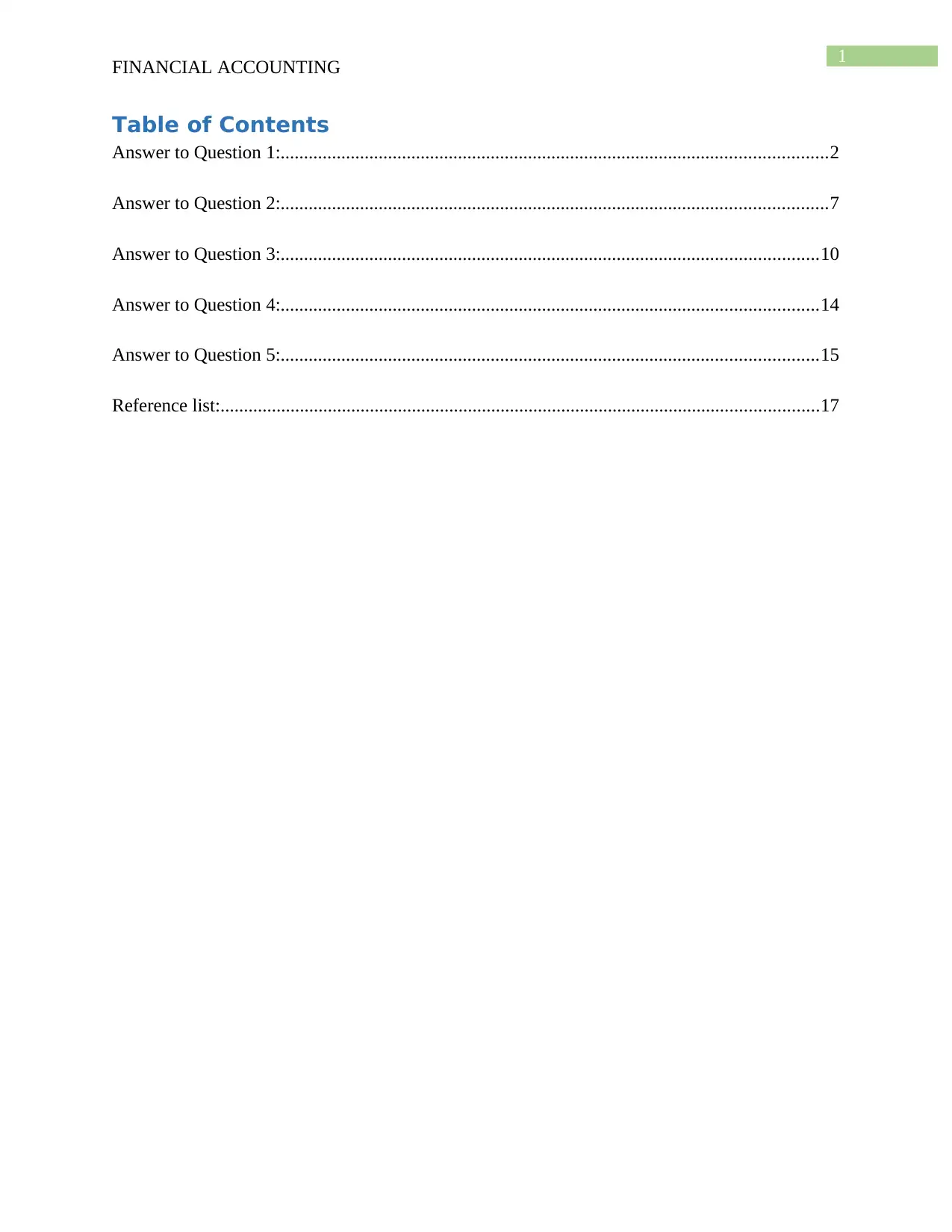
1
FINANCIAL ACCOUNTING
Table of Contents
Answer to Question 1:.....................................................................................................................2
Answer to Question 2:.....................................................................................................................7
Answer to Question 3:...................................................................................................................10
Answer to Question 4:...................................................................................................................14
Answer to Question 5:...................................................................................................................15
Reference list:................................................................................................................................17
FINANCIAL ACCOUNTING
Table of Contents
Answer to Question 1:.....................................................................................................................2
Answer to Question 2:.....................................................................................................................7
Answer to Question 3:...................................................................................................................10
Answer to Question 4:...................................................................................................................14
Answer to Question 5:...................................................................................................................15
Reference list:................................................................................................................................17
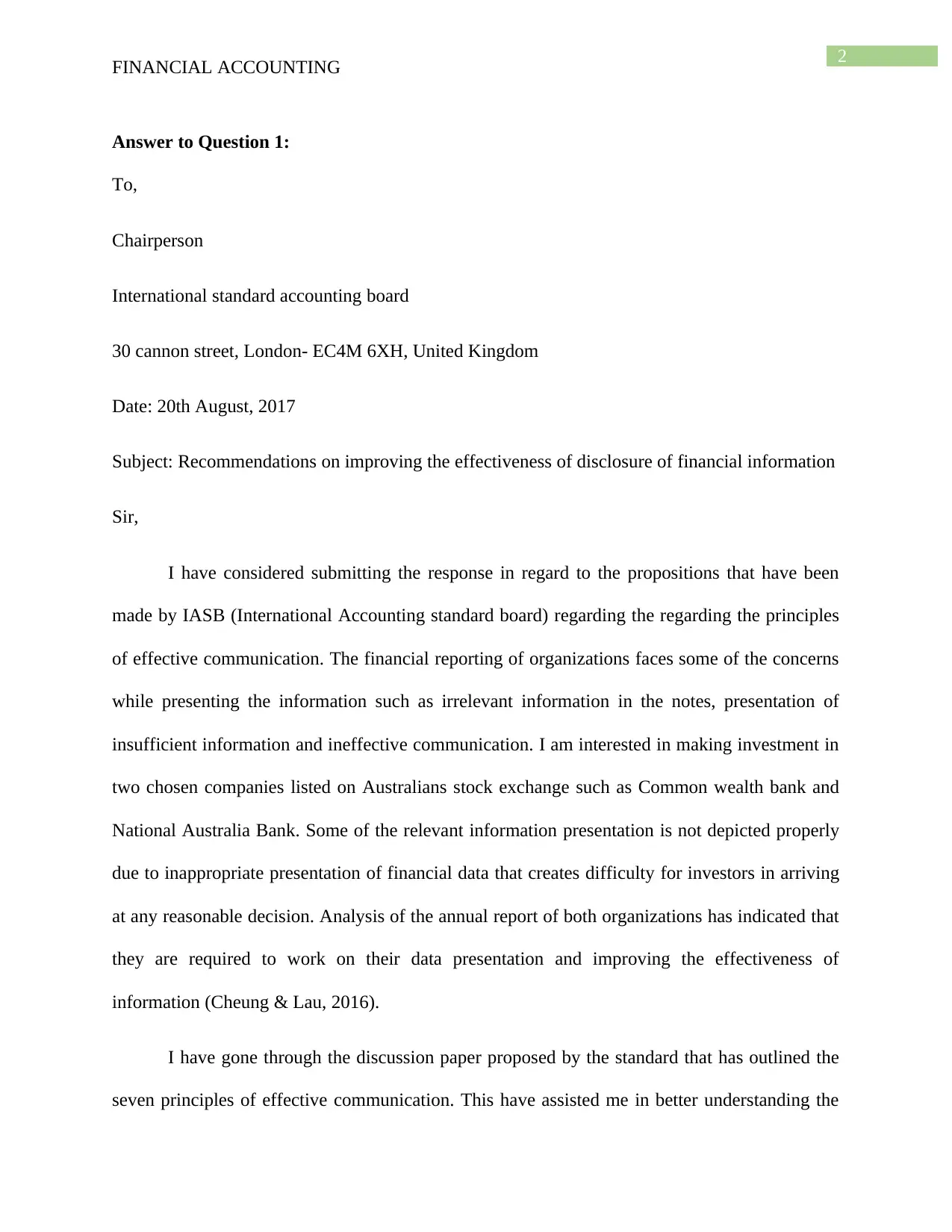
2
FINANCIAL ACCOUNTING
Answer to Question 1:
To,
Chairperson
International standard accounting board
30 cannon street, London- EC4M 6XH, United Kingdom
Date: 20th August, 2017
Subject: Recommendations on improving the effectiveness of disclosure of financial information
Sir,
I have considered submitting the response in regard to the propositions that have been
made by IASB (International Accounting standard board) regarding the regarding the principles
of effective communication. The financial reporting of organizations faces some of the concerns
while presenting the information such as irrelevant information in the notes, presentation of
insufficient information and ineffective communication. I am interested in making investment in
two chosen companies listed on Australians stock exchange such as Common wealth bank and
National Australia Bank. Some of the relevant information presentation is not depicted properly
due to inappropriate presentation of financial data that creates difficulty for investors in arriving
at any reasonable decision. Analysis of the annual report of both organizations has indicated that
they are required to work on their data presentation and improving the effectiveness of
information (Cheung & Lau, 2016).
I have gone through the discussion paper proposed by the standard that has outlined the
seven principles of effective communication. This have assisted me in better understanding the
FINANCIAL ACCOUNTING
Answer to Question 1:
To,
Chairperson
International standard accounting board
30 cannon street, London- EC4M 6XH, United Kingdom
Date: 20th August, 2017
Subject: Recommendations on improving the effectiveness of disclosure of financial information
Sir,
I have considered submitting the response in regard to the propositions that have been
made by IASB (International Accounting standard board) regarding the regarding the principles
of effective communication. The financial reporting of organizations faces some of the concerns
while presenting the information such as irrelevant information in the notes, presentation of
insufficient information and ineffective communication. I am interested in making investment in
two chosen companies listed on Australians stock exchange such as Common wealth bank and
National Australia Bank. Some of the relevant information presentation is not depicted properly
due to inappropriate presentation of financial data that creates difficulty for investors in arriving
at any reasonable decision. Analysis of the annual report of both organizations has indicated that
they are required to work on their data presentation and improving the effectiveness of
information (Cheung & Lau, 2016).
I have gone through the discussion paper proposed by the standard that has outlined the
seven principles of effective communication. This have assisted me in better understanding the
⊘ This is a preview!⊘
Do you want full access?
Subscribe today to unlock all pages.

Trusted by 1+ million students worldwide
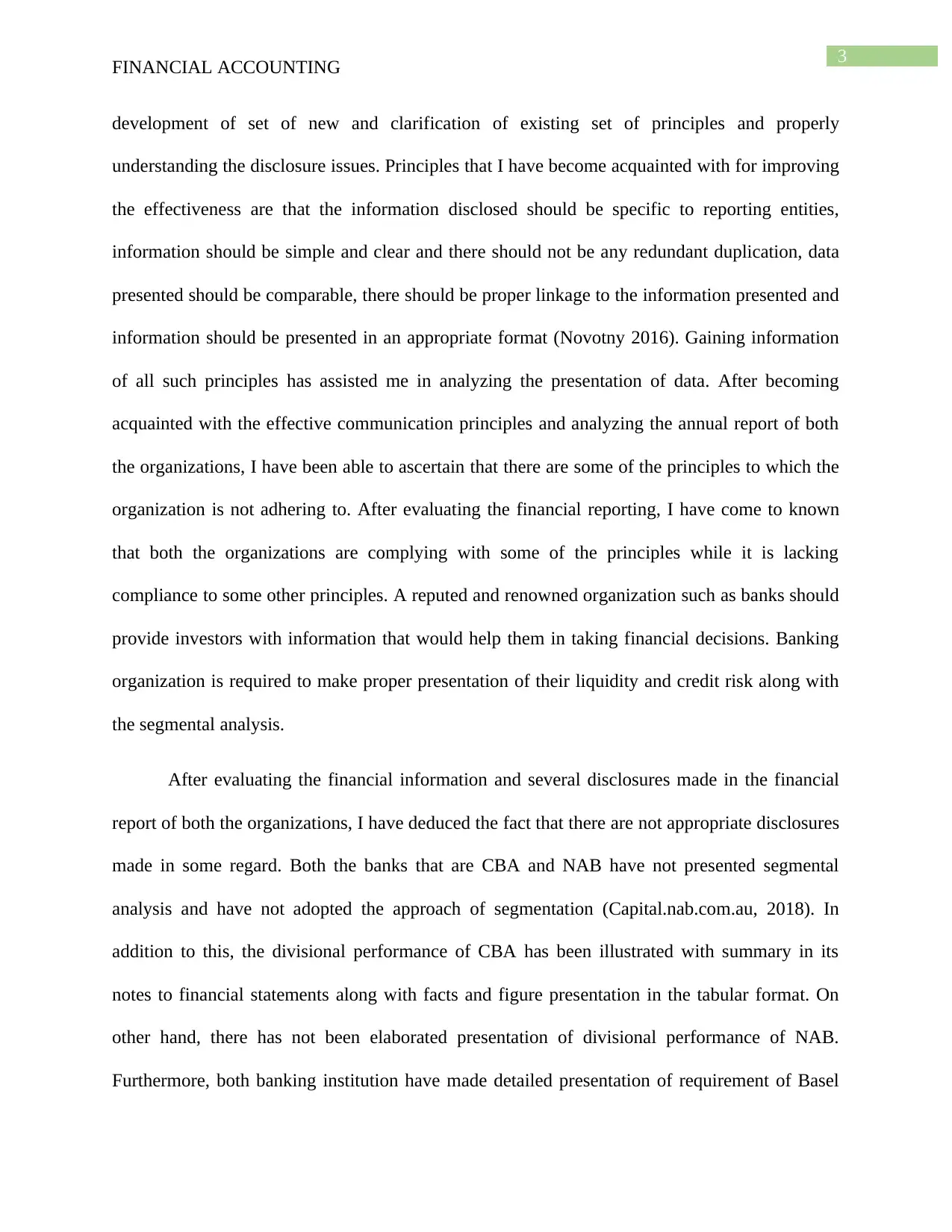
3
FINANCIAL ACCOUNTING
development of set of new and clarification of existing set of principles and properly
understanding the disclosure issues. Principles that I have become acquainted with for improving
the effectiveness are that the information disclosed should be specific to reporting entities,
information should be simple and clear and there should not be any redundant duplication, data
presented should be comparable, there should be proper linkage to the information presented and
information should be presented in an appropriate format (Novotny 2016). Gaining information
of all such principles has assisted me in analyzing the presentation of data. After becoming
acquainted with the effective communication principles and analyzing the annual report of both
the organizations, I have been able to ascertain that there are some of the principles to which the
organization is not adhering to. After evaluating the financial reporting, I have come to known
that both the organizations are complying with some of the principles while it is lacking
compliance to some other principles. A reputed and renowned organization such as banks should
provide investors with information that would help them in taking financial decisions. Banking
organization is required to make proper presentation of their liquidity and credit risk along with
the segmental analysis.
After evaluating the financial information and several disclosures made in the financial
report of both the organizations, I have deduced the fact that there are not appropriate disclosures
made in some regard. Both the banks that are CBA and NAB have not presented segmental
analysis and have not adopted the approach of segmentation (Capital.nab.com.au, 2018). In
addition to this, the divisional performance of CBA has been illustrated with summary in its
notes to financial statements along with facts and figure presentation in the tabular format. On
other hand, there has not been elaborated presentation of divisional performance of NAB.
Furthermore, both banking institution have made detailed presentation of requirement of Basel
FINANCIAL ACCOUNTING
development of set of new and clarification of existing set of principles and properly
understanding the disclosure issues. Principles that I have become acquainted with for improving
the effectiveness are that the information disclosed should be specific to reporting entities,
information should be simple and clear and there should not be any redundant duplication, data
presented should be comparable, there should be proper linkage to the information presented and
information should be presented in an appropriate format (Novotny 2016). Gaining information
of all such principles has assisted me in analyzing the presentation of data. After becoming
acquainted with the effective communication principles and analyzing the annual report of both
the organizations, I have been able to ascertain that there are some of the principles to which the
organization is not adhering to. After evaluating the financial reporting, I have come to known
that both the organizations are complying with some of the principles while it is lacking
compliance to some other principles. A reputed and renowned organization such as banks should
provide investors with information that would help them in taking financial decisions. Banking
organization is required to make proper presentation of their liquidity and credit risk along with
the segmental analysis.
After evaluating the financial information and several disclosures made in the financial
report of both the organizations, I have deduced the fact that there are not appropriate disclosures
made in some regard. Both the banks that are CBA and NAB have not presented segmental
analysis and have not adopted the approach of segmentation (Capital.nab.com.au, 2018). In
addition to this, the divisional performance of CBA has been illustrated with summary in its
notes to financial statements along with facts and figure presentation in the tabular format. On
other hand, there has not been elaborated presentation of divisional performance of NAB.
Furthermore, both banking institution have made detailed presentation of requirement of Basel
Paraphrase This Document
Need a fresh take? Get an instant paraphrase of this document with our AI Paraphraser
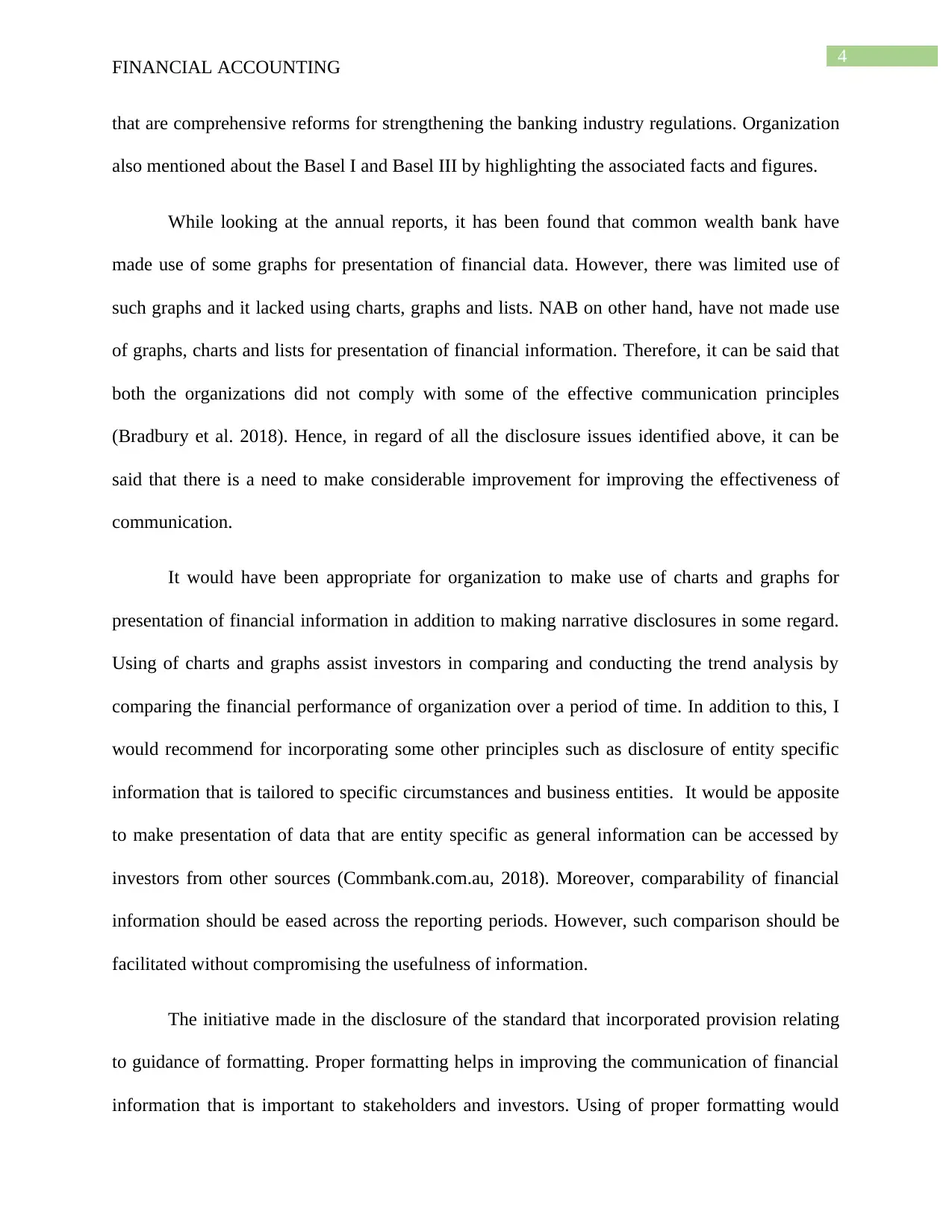
4
FINANCIAL ACCOUNTING
that are comprehensive reforms for strengthening the banking industry regulations. Organization
also mentioned about the Basel I and Basel III by highlighting the associated facts and figures.
While looking at the annual reports, it has been found that common wealth bank have
made use of some graphs for presentation of financial data. However, there was limited use of
such graphs and it lacked using charts, graphs and lists. NAB on other hand, have not made use
of graphs, charts and lists for presentation of financial information. Therefore, it can be said that
both the organizations did not comply with some of the effective communication principles
(Bradbury et al. 2018). Hence, in regard of all the disclosure issues identified above, it can be
said that there is a need to make considerable improvement for improving the effectiveness of
communication.
It would have been appropriate for organization to make use of charts and graphs for
presentation of financial information in addition to making narrative disclosures in some regard.
Using of charts and graphs assist investors in comparing and conducting the trend analysis by
comparing the financial performance of organization over a period of time. In addition to this, I
would recommend for incorporating some other principles such as disclosure of entity specific
information that is tailored to specific circumstances and business entities. It would be apposite
to make presentation of data that are entity specific as general information can be accessed by
investors from other sources (Commbank.com.au, 2018). Moreover, comparability of financial
information should be eased across the reporting periods. However, such comparison should be
facilitated without compromising the usefulness of information.
The initiative made in the disclosure of the standard that incorporated provision relating
to guidance of formatting. Proper formatting helps in improving the communication of financial
information that is important to stakeholders and investors. Using of proper formatting would
FINANCIAL ACCOUNTING
that are comprehensive reforms for strengthening the banking industry regulations. Organization
also mentioned about the Basel I and Basel III by highlighting the associated facts and figures.
While looking at the annual reports, it has been found that common wealth bank have
made use of some graphs for presentation of financial data. However, there was limited use of
such graphs and it lacked using charts, graphs and lists. NAB on other hand, have not made use
of graphs, charts and lists for presentation of financial information. Therefore, it can be said that
both the organizations did not comply with some of the effective communication principles
(Bradbury et al. 2018). Hence, in regard of all the disclosure issues identified above, it can be
said that there is a need to make considerable improvement for improving the effectiveness of
communication.
It would have been appropriate for organization to make use of charts and graphs for
presentation of financial information in addition to making narrative disclosures in some regard.
Using of charts and graphs assist investors in comparing and conducting the trend analysis by
comparing the financial performance of organization over a period of time. In addition to this, I
would recommend for incorporating some other principles such as disclosure of entity specific
information that is tailored to specific circumstances and business entities. It would be apposite
to make presentation of data that are entity specific as general information can be accessed by
investors from other sources (Commbank.com.au, 2018). Moreover, comparability of financial
information should be eased across the reporting periods. However, such comparison should be
facilitated without compromising the usefulness of information.
The initiative made in the disclosure of the standard that incorporated provision relating
to guidance of formatting. Proper formatting helps in improving the communication of financial
information that is important to stakeholders and investors. Using of proper formatting would
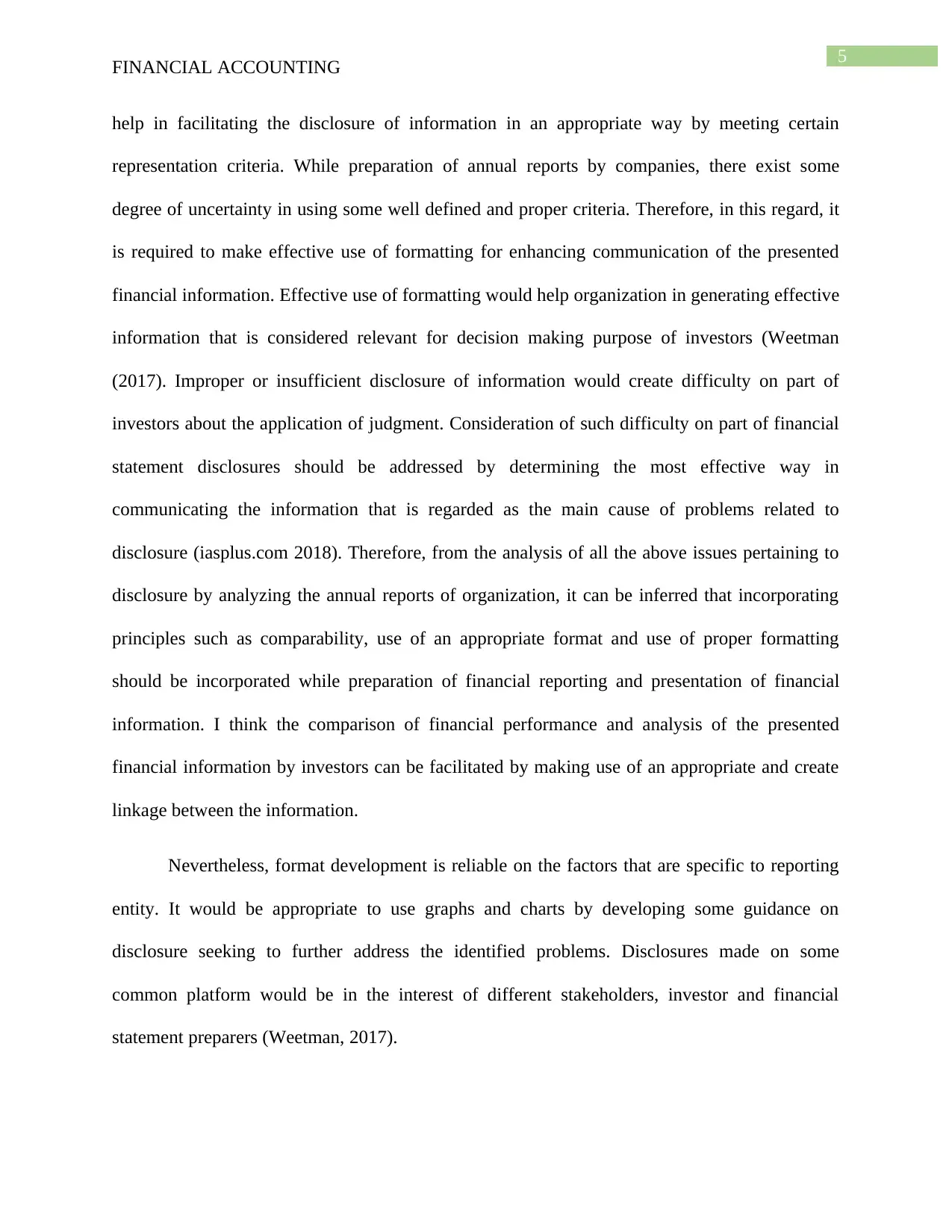
5
FINANCIAL ACCOUNTING
help in facilitating the disclosure of information in an appropriate way by meeting certain
representation criteria. While preparation of annual reports by companies, there exist some
degree of uncertainty in using some well defined and proper criteria. Therefore, in this regard, it
is required to make effective use of formatting for enhancing communication of the presented
financial information. Effective use of formatting would help organization in generating effective
information that is considered relevant for decision making purpose of investors (Weetman
(2017). Improper or insufficient disclosure of information would create difficulty on part of
investors about the application of judgment. Consideration of such difficulty on part of financial
statement disclosures should be addressed by determining the most effective way in
communicating the information that is regarded as the main cause of problems related to
disclosure (iasplus.com 2018). Therefore, from the analysis of all the above issues pertaining to
disclosure by analyzing the annual reports of organization, it can be inferred that incorporating
principles such as comparability, use of an appropriate format and use of proper formatting
should be incorporated while preparation of financial reporting and presentation of financial
information. I think the comparison of financial performance and analysis of the presented
financial information by investors can be facilitated by making use of an appropriate and create
linkage between the information.
Nevertheless, format development is reliable on the factors that are specific to reporting
entity. It would be appropriate to use graphs and charts by developing some guidance on
disclosure seeking to further address the identified problems. Disclosures made on some
common platform would be in the interest of different stakeholders, investor and financial
statement preparers (Weetman, 2017).
FINANCIAL ACCOUNTING
help in facilitating the disclosure of information in an appropriate way by meeting certain
representation criteria. While preparation of annual reports by companies, there exist some
degree of uncertainty in using some well defined and proper criteria. Therefore, in this regard, it
is required to make effective use of formatting for enhancing communication of the presented
financial information. Effective use of formatting would help organization in generating effective
information that is considered relevant for decision making purpose of investors (Weetman
(2017). Improper or insufficient disclosure of information would create difficulty on part of
investors about the application of judgment. Consideration of such difficulty on part of financial
statement disclosures should be addressed by determining the most effective way in
communicating the information that is regarded as the main cause of problems related to
disclosure (iasplus.com 2018). Therefore, from the analysis of all the above issues pertaining to
disclosure by analyzing the annual reports of organization, it can be inferred that incorporating
principles such as comparability, use of an appropriate format and use of proper formatting
should be incorporated while preparation of financial reporting and presentation of financial
information. I think the comparison of financial performance and analysis of the presented
financial information by investors can be facilitated by making use of an appropriate and create
linkage between the information.
Nevertheless, format development is reliable on the factors that are specific to reporting
entity. It would be appropriate to use graphs and charts by developing some guidance on
disclosure seeking to further address the identified problems. Disclosures made on some
common platform would be in the interest of different stakeholders, investor and financial
statement preparers (Weetman, 2017).
⊘ This is a preview!⊘
Do you want full access?
Subscribe today to unlock all pages.

Trusted by 1+ million students worldwide
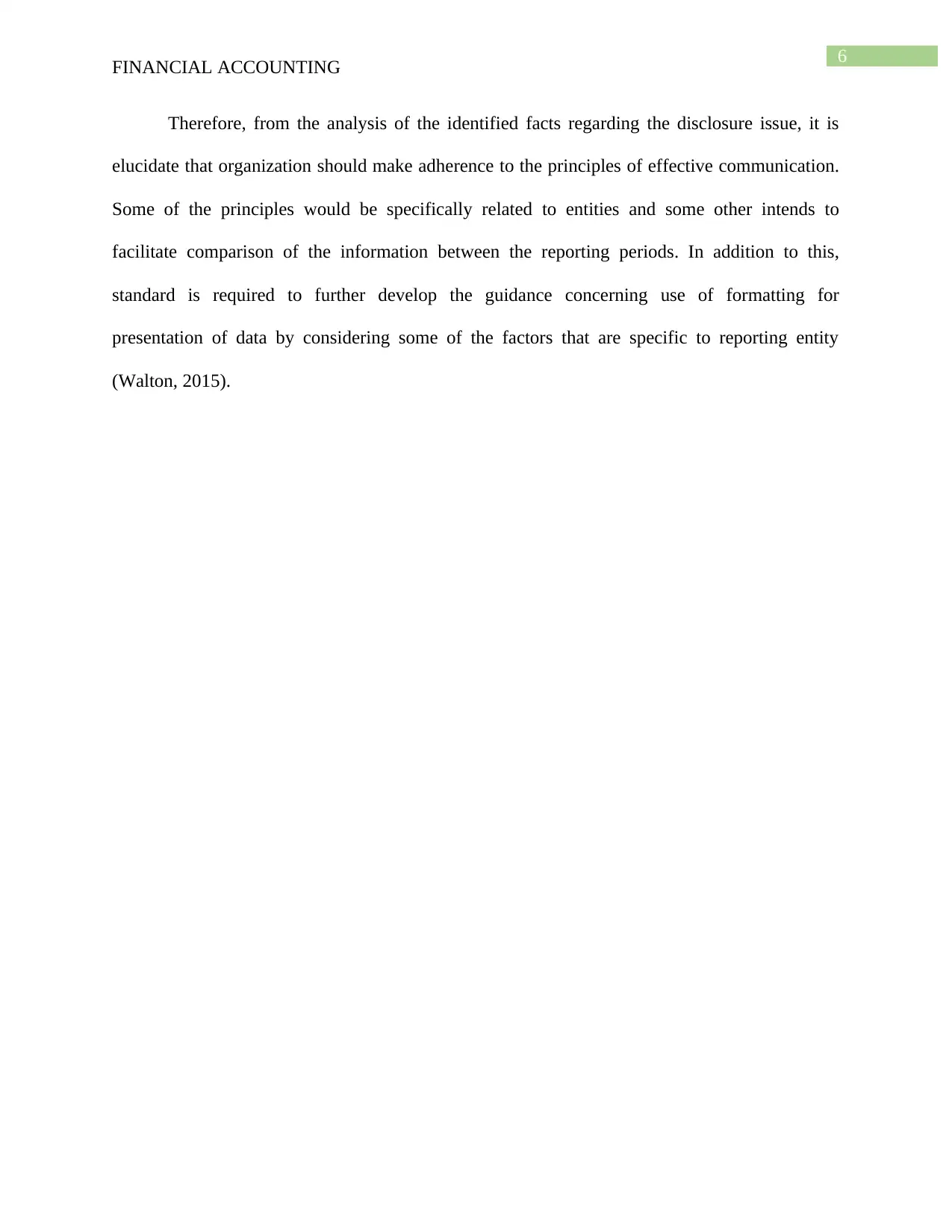
6
FINANCIAL ACCOUNTING
Therefore, from the analysis of the identified facts regarding the disclosure issue, it is
elucidate that organization should make adherence to the principles of effective communication.
Some of the principles would be specifically related to entities and some other intends to
facilitate comparison of the information between the reporting periods. In addition to this,
standard is required to further develop the guidance concerning use of formatting for
presentation of data by considering some of the factors that are specific to reporting entity
(Walton, 2015).
FINANCIAL ACCOUNTING
Therefore, from the analysis of the identified facts regarding the disclosure issue, it is
elucidate that organization should make adherence to the principles of effective communication.
Some of the principles would be specifically related to entities and some other intends to
facilitate comparison of the information between the reporting periods. In addition to this,
standard is required to further develop the guidance concerning use of formatting for
presentation of data by considering some of the factors that are specific to reporting entity
(Walton, 2015).
Paraphrase This Document
Need a fresh take? Get an instant paraphrase of this document with our AI Paraphraser
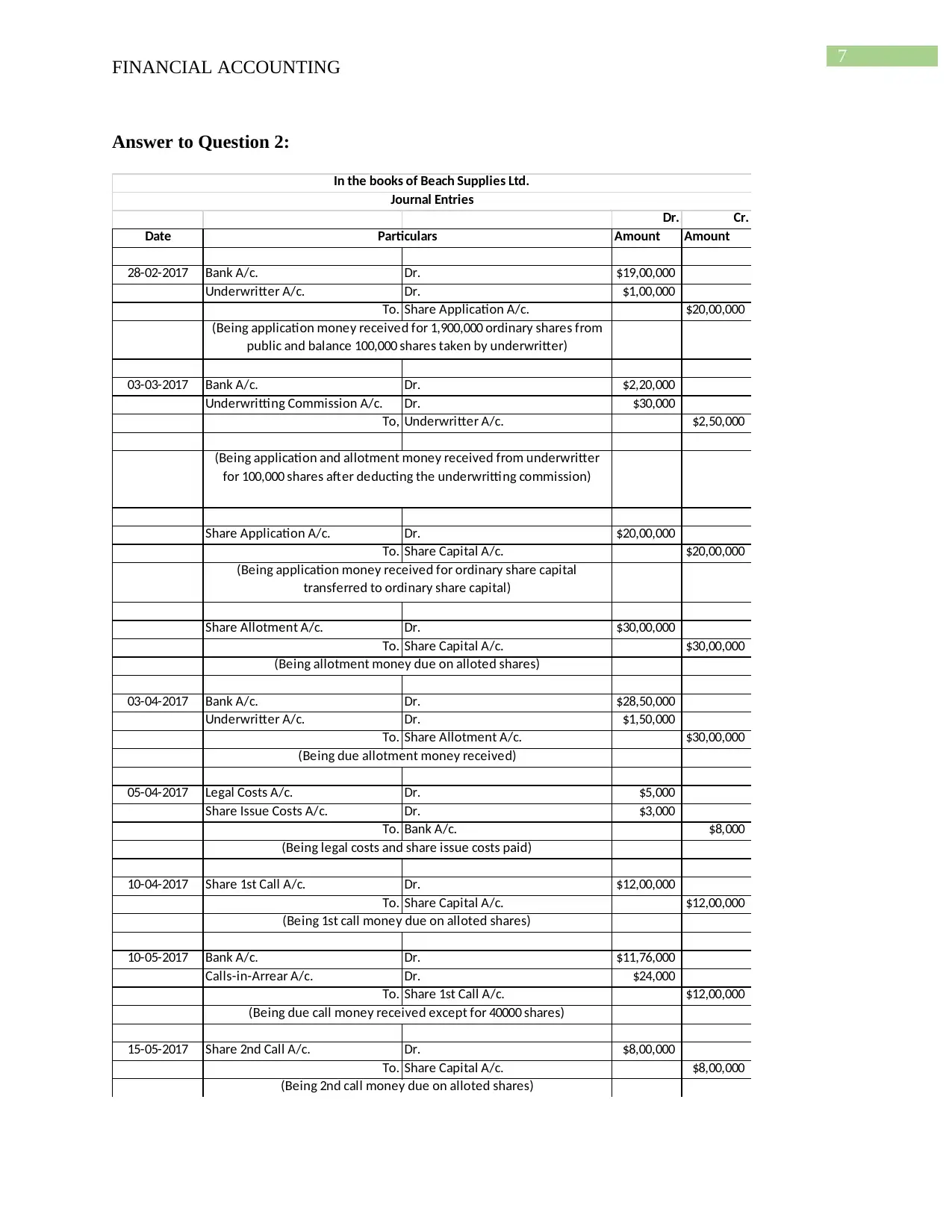
7
FINANCIAL ACCOUNTING
Answer to Question 2:
Dr. Cr.
Date Amount Amount
28-02-2017 Bank A/c. Dr. $19,00,000
Underwritter A/c. Dr. $1,00,000
To. Share Application A/c. $20,00,000
03-03-2017 Bank A/c. Dr. $2,20,000
Underwritting Commission A/c. Dr. $30,000
To, Underwritter A/c. $2,50,000
Share Application A/c. Dr. $20,00,000
To. Share Capital A/c. $20,00,000
Share Allotment A/c. Dr. $30,00,000
To. Share Capital A/c. $30,00,000
03-04-2017 Bank A/c. Dr. $28,50,000
Underwritter A/c. Dr. $1,50,000
To. Share Allotment A/c. $30,00,000
05-04-2017 Legal Costs A/c. Dr. $5,000
Share Issue Costs A/c. Dr. $3,000
To. Bank A/c. $8,000
10-04-2017 Share 1st Call A/c. Dr. $12,00,000
To. Share Capital A/c. $12,00,000
10-05-2017 Bank A/c. Dr. $11,76,000
Calls-in-Arrear A/c. Dr. $24,000
To. Share 1st Call A/c. $12,00,000
15-05-2017 Share 2nd Call A/c. Dr. $8,00,000
To. Share Capital A/c. $8,00,000
Particulars
(Being application money received for 1,900,000 ordinary shares from
public and balance 100,000 shares taken by underwritter)
(Being application and allotment money received from underwritter
for 100,000 shares after deducting the underwritting commission)
(Being application money received for ordinary share capital
transferred to ordinary share capital)
(Being allotment money due on alloted shares)
(Being due allotment money received)
(Being 1st call money due on alloted shares)
(Being due call money received except for 40000 shares)
(Being legal costs and share issue costs paid)
(Being 2nd call money due on alloted shares)
In the books of Beach Supplies Ltd.
Journal Entries
FINANCIAL ACCOUNTING
Answer to Question 2:
Dr. Cr.
Date Amount Amount
28-02-2017 Bank A/c. Dr. $19,00,000
Underwritter A/c. Dr. $1,00,000
To. Share Application A/c. $20,00,000
03-03-2017 Bank A/c. Dr. $2,20,000
Underwritting Commission A/c. Dr. $30,000
To, Underwritter A/c. $2,50,000
Share Application A/c. Dr. $20,00,000
To. Share Capital A/c. $20,00,000
Share Allotment A/c. Dr. $30,00,000
To. Share Capital A/c. $30,00,000
03-04-2017 Bank A/c. Dr. $28,50,000
Underwritter A/c. Dr. $1,50,000
To. Share Allotment A/c. $30,00,000
05-04-2017 Legal Costs A/c. Dr. $5,000
Share Issue Costs A/c. Dr. $3,000
To. Bank A/c. $8,000
10-04-2017 Share 1st Call A/c. Dr. $12,00,000
To. Share Capital A/c. $12,00,000
10-05-2017 Bank A/c. Dr. $11,76,000
Calls-in-Arrear A/c. Dr. $24,000
To. Share 1st Call A/c. $12,00,000
15-05-2017 Share 2nd Call A/c. Dr. $8,00,000
To. Share Capital A/c. $8,00,000
Particulars
(Being application money received for 1,900,000 ordinary shares from
public and balance 100,000 shares taken by underwritter)
(Being application and allotment money received from underwritter
for 100,000 shares after deducting the underwritting commission)
(Being application money received for ordinary share capital
transferred to ordinary share capital)
(Being allotment money due on alloted shares)
(Being due allotment money received)
(Being 1st call money due on alloted shares)
(Being due call money received except for 40000 shares)
(Being legal costs and share issue costs paid)
(Being 2nd call money due on alloted shares)
In the books of Beach Supplies Ltd.
Journal Entries
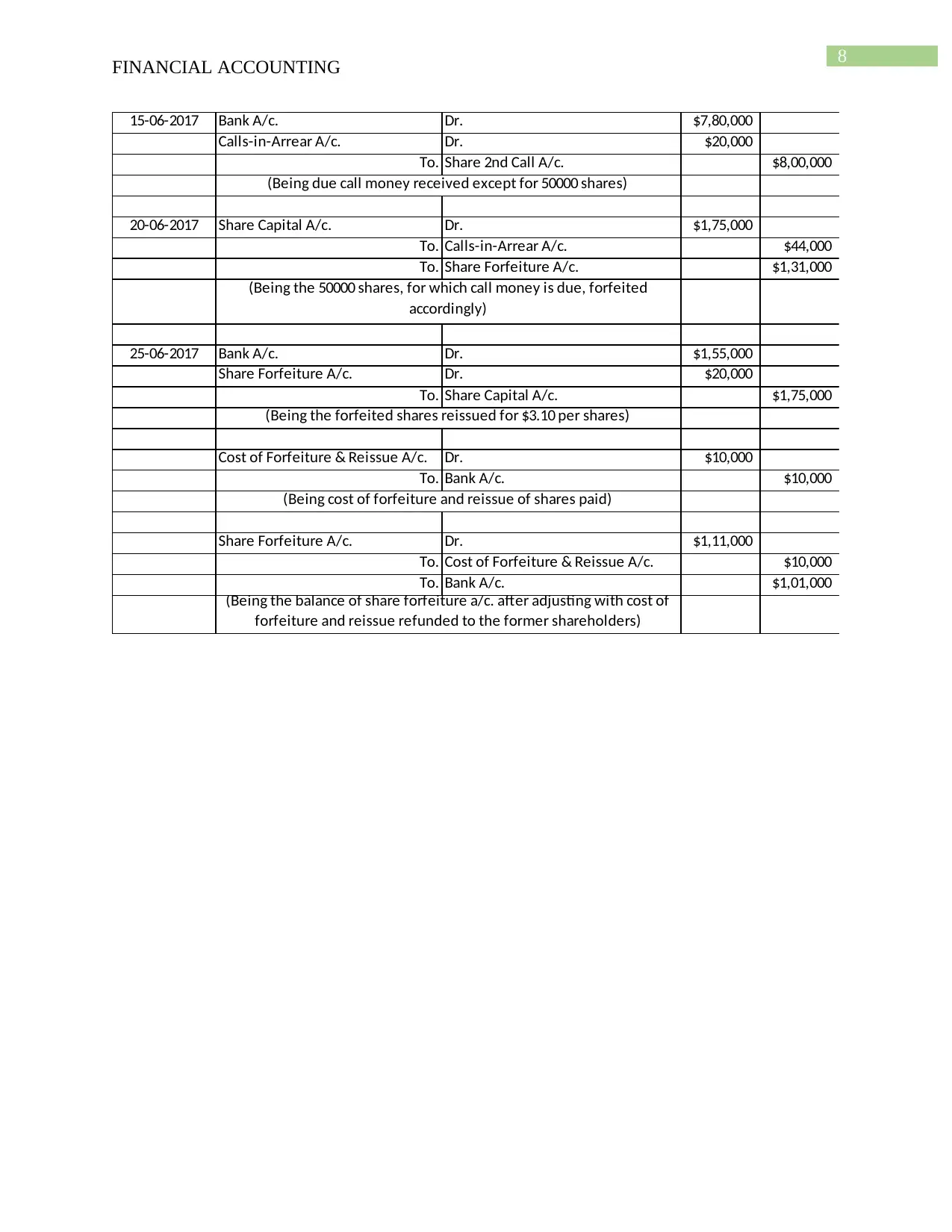
8
FINANCIAL ACCOUNTING
15-06-2017 Bank A/c. Dr. $7,80,000
Calls-in-Arrear A/c. Dr. $20,000
To. Share 2nd Call A/c. $8,00,000
20-06-2017 Share Capital A/c. Dr. $1,75,000
To. Calls-in-Arrear A/c. $44,000
To. Share Forfeiture A/c. $1,31,000
25-06-2017 Bank A/c. Dr. $1,55,000
Share Forfeiture A/c. Dr. $20,000
To. Share Capital A/c. $1,75,000
Cost of Forfeiture & Reissue A/c. Dr. $10,000
To. Bank A/c. $10,000
Share Forfeiture A/c. Dr. $1,11,000
To. Cost of Forfeiture & Reissue A/c. $10,000
To. Bank A/c. $1,01,000
(Being the balance of share forfeiture a/c. after adjusting with cost of
forfeiture and reissue refunded to the former shareholders)
(Being the 50000 shares, for which call money is due, forfeited
accordingly)
(Being the forfeited shares reissued for $3.10 per shares)
(Being cost of forfeiture and reissue of shares paid)
(Being due call money received except for 50000 shares)
FINANCIAL ACCOUNTING
15-06-2017 Bank A/c. Dr. $7,80,000
Calls-in-Arrear A/c. Dr. $20,000
To. Share 2nd Call A/c. $8,00,000
20-06-2017 Share Capital A/c. Dr. $1,75,000
To. Calls-in-Arrear A/c. $44,000
To. Share Forfeiture A/c. $1,31,000
25-06-2017 Bank A/c. Dr. $1,55,000
Share Forfeiture A/c. Dr. $20,000
To. Share Capital A/c. $1,75,000
Cost of Forfeiture & Reissue A/c. Dr. $10,000
To. Bank A/c. $10,000
Share Forfeiture A/c. Dr. $1,11,000
To. Cost of Forfeiture & Reissue A/c. $10,000
To. Bank A/c. $1,01,000
(Being the balance of share forfeiture a/c. after adjusting with cost of
forfeiture and reissue refunded to the former shareholders)
(Being the 50000 shares, for which call money is due, forfeited
accordingly)
(Being the forfeited shares reissued for $3.10 per shares)
(Being cost of forfeiture and reissue of shares paid)
(Being due call money received except for 50000 shares)
⊘ This is a preview!⊘
Do you want full access?
Subscribe today to unlock all pages.

Trusted by 1+ million students worldwide
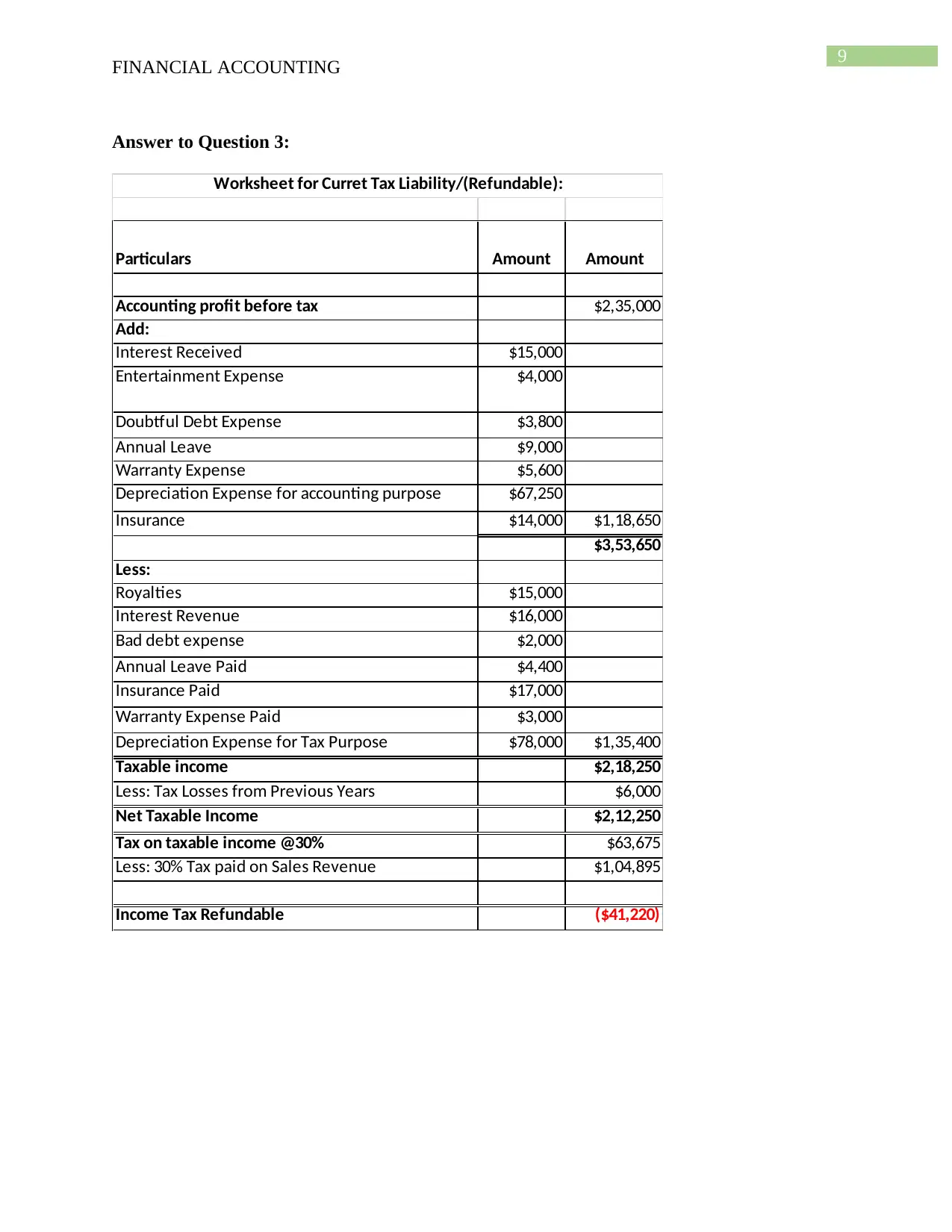
9
FINANCIAL ACCOUNTING
Answer to Question 3:
Particulars Amount Amount
Accounting profit before tax $2,35,000
Add:
Interest Received $15,000
Entertainment Expense $4,000
Doubtful Debt Expense $3,800
Annual Leave $9,000
Warranty Expense $5,600
Depreciation Expense for accounting purpose $67,250
Insurance $14,000 $1,18,650
$3,53,650
Less:
Royalties $15,000
Interest Revenue $16,000
Bad debt expense $2,000
Annual Leave Paid $4,400
Insurance Paid $17,000
Warranty Expense Paid $3,000
Depreciation Expense for Tax Purpose $78,000 $1,35,400
Taxable income $2,18,250
Less: Tax Losses from Previous Years $6,000
Net Taxable Income $2,12,250
Tax on taxable income @30% $63,675
Less: 30% Tax paid on Sales Revenue $1,04,895
Income Tax Refundable ($41,220)
Worksheet for Curret Tax Liability/(Refundable):
FINANCIAL ACCOUNTING
Answer to Question 3:
Particulars Amount Amount
Accounting profit before tax $2,35,000
Add:
Interest Received $15,000
Entertainment Expense $4,000
Doubtful Debt Expense $3,800
Annual Leave $9,000
Warranty Expense $5,600
Depreciation Expense for accounting purpose $67,250
Insurance $14,000 $1,18,650
$3,53,650
Less:
Royalties $15,000
Interest Revenue $16,000
Bad debt expense $2,000
Annual Leave Paid $4,400
Insurance Paid $17,000
Warranty Expense Paid $3,000
Depreciation Expense for Tax Purpose $78,000 $1,35,400
Taxable income $2,18,250
Less: Tax Losses from Previous Years $6,000
Net Taxable Income $2,12,250
Tax on taxable income @30% $63,675
Less: 30% Tax paid on Sales Revenue $1,04,895
Income Tax Refundable ($41,220)
Worksheet for Curret Tax Liability/(Refundable):
Paraphrase This Document
Need a fresh take? Get an instant paraphrase of this document with our AI Paraphraser
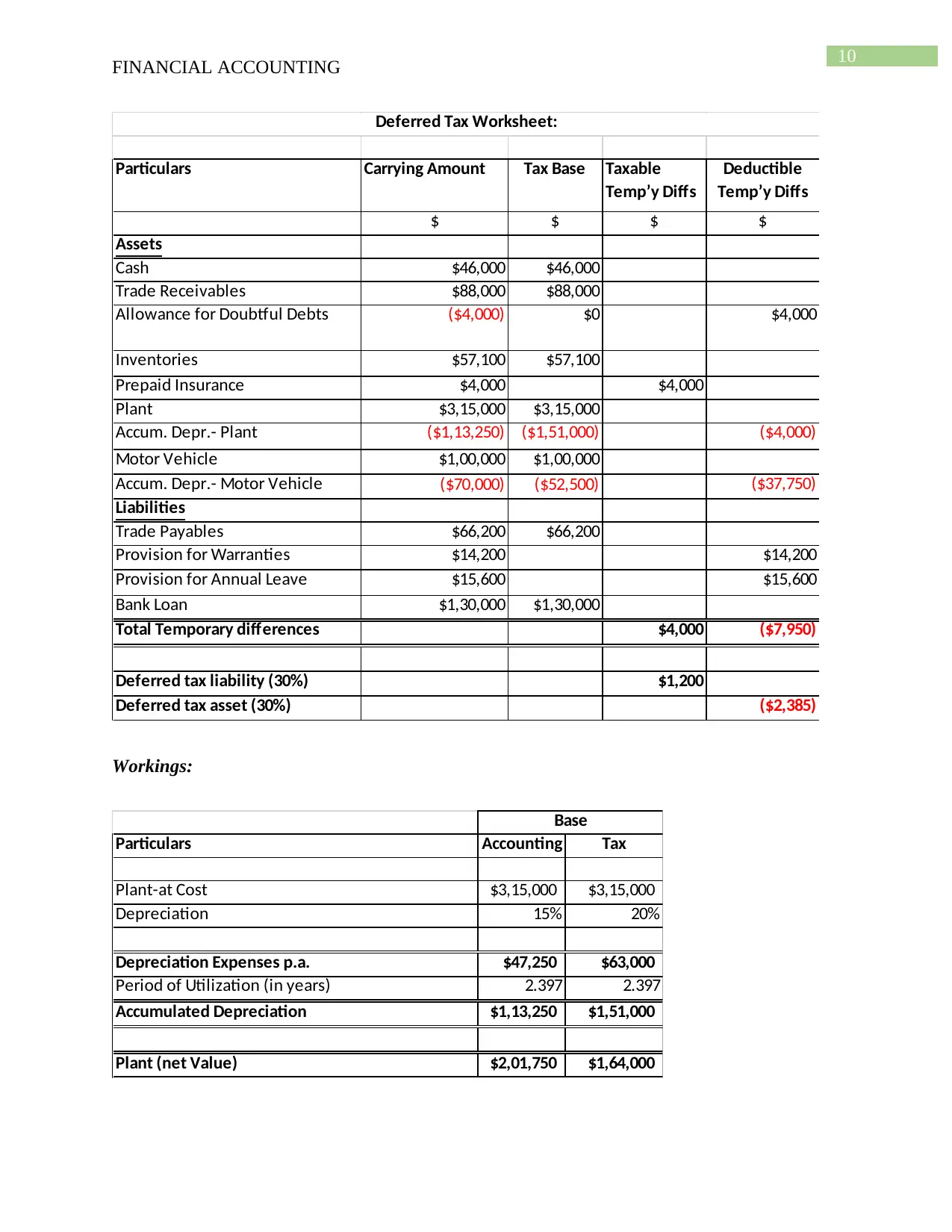
10
FINANCIAL ACCOUNTING
Particulars Carrying Amount Tax Base Taxable
Temp’y Diffs
Deductible
Temp’y Diffs
$ $ $ $
Assets
Cash $46,000 $46,000
Trade Receivables $88,000 $88,000
Allowance for Doubtful Debts ($4,000) $0 $4,000
Inventories $57,100 $57,100
Prepaid Insurance $4,000 $4,000
Plant $3,15,000 $3,15,000
Accum. Depr.- Plant ($1,13,250) ($1,51,000) ($4,000)
Motor Vehicle $1,00,000 $1,00,000
Accum. Depr.- Motor Vehicle ($70,000) ($52,500) ($37,750)
Liabilities
Trade Payables $66,200 $66,200
Provision for Warranties $14,200 $14,200
Provision for Annual Leave $15,600 $15,600
Bank Loan $1,30,000 $1,30,000
Total Temporary differences $4,000 ($7,950)
Deferred tax liability (30%) $1,200
Deferred tax asset (30%) ($2,385)
Deferred Tax Worksheet:
Workings:
Particulars Accounting Tax
Plant-at Cost $3,15,000 $3,15,000
Depreciation 15% 20%
Depreciation Expenses p.a. $47,250 $63,000
Period of Utilization (in years) 2.397 2.397
Accumulated Depreciation $1,13,250 $1,51,000
Plant (net Value) $2,01,750 $1,64,000
Base
FINANCIAL ACCOUNTING
Particulars Carrying Amount Tax Base Taxable
Temp’y Diffs
Deductible
Temp’y Diffs
$ $ $ $
Assets
Cash $46,000 $46,000
Trade Receivables $88,000 $88,000
Allowance for Doubtful Debts ($4,000) $0 $4,000
Inventories $57,100 $57,100
Prepaid Insurance $4,000 $4,000
Plant $3,15,000 $3,15,000
Accum. Depr.- Plant ($1,13,250) ($1,51,000) ($4,000)
Motor Vehicle $1,00,000 $1,00,000
Accum. Depr.- Motor Vehicle ($70,000) ($52,500) ($37,750)
Liabilities
Trade Payables $66,200 $66,200
Provision for Warranties $14,200 $14,200
Provision for Annual Leave $15,600 $15,600
Bank Loan $1,30,000 $1,30,000
Total Temporary differences $4,000 ($7,950)
Deferred tax liability (30%) $1,200
Deferred tax asset (30%) ($2,385)
Deferred Tax Worksheet:
Workings:
Particulars Accounting Tax
Plant-at Cost $3,15,000 $3,15,000
Depreciation 15% 20%
Depreciation Expenses p.a. $47,250 $63,000
Period of Utilization (in years) 2.397 2.397
Accumulated Depreciation $1,13,250 $1,51,000
Plant (net Value) $2,01,750 $1,64,000
Base
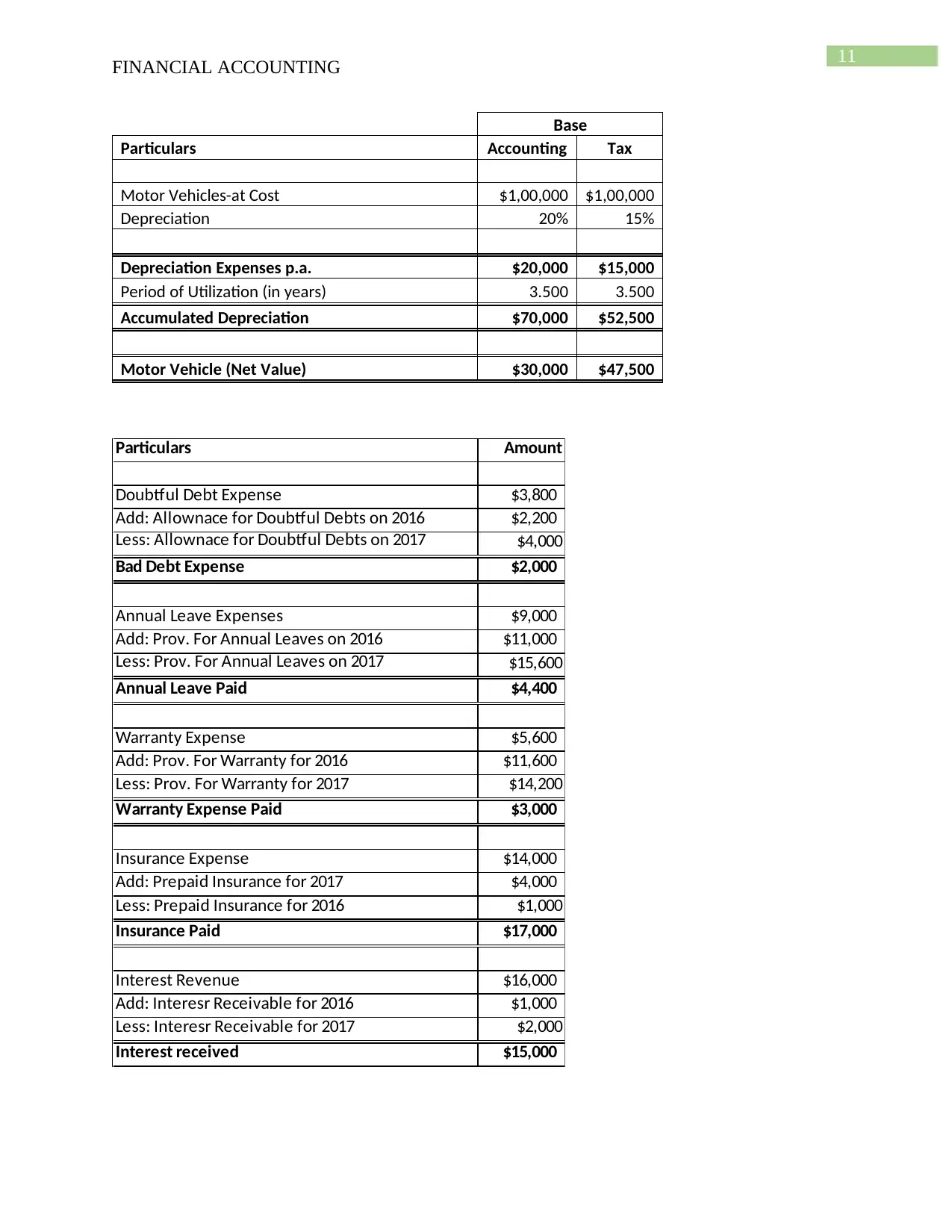
11
FINANCIAL ACCOUNTING
Base
Particulars Accounting Tax
Motor Vehicles-at Cost $1,00,000 $1,00,000
Depreciation 20% 15%
Depreciation Expenses p.a. $20,000 $15,000
Period of Utilization (in years) 3.500 3.500
Accumulated Depreciation $70,000 $52,500
Motor Vehicle (Net Value) $30,000 $47,500
Particulars Amount
Doubtful Debt Expense $3,800
Add: Allownace for Doubtful Debts on 2016 $2,200
Less: Allownace for Doubtful Debts on 2017 $4,000
Bad Debt Expense $2,000
Annual Leave Expenses $9,000
Add: Prov. For Annual Leaves on 2016 $11,000
Less: Prov. For Annual Leaves on 2017 $15,600
Annual Leave Paid $4,400
Warranty Expense $5,600
Add: Prov. For Warranty for 2016 $11,600
Less: Prov. For Warranty for 2017 $14,200
Warranty Expense Paid $3,000
Insurance Expense $14,000
Add: Prepaid Insurance for 2017 $4,000
Less: Prepaid Insurance for 2016 $1,000
Insurance Paid $17,000
Interest Revenue $16,000
Add: Interesr Receivable for 2016 $1,000
Less: Interesr Receivable for 2017 $2,000
Interest received $15,000
FINANCIAL ACCOUNTING
Base
Particulars Accounting Tax
Motor Vehicles-at Cost $1,00,000 $1,00,000
Depreciation 20% 15%
Depreciation Expenses p.a. $20,000 $15,000
Period of Utilization (in years) 3.500 3.500
Accumulated Depreciation $70,000 $52,500
Motor Vehicle (Net Value) $30,000 $47,500
Particulars Amount
Doubtful Debt Expense $3,800
Add: Allownace for Doubtful Debts on 2016 $2,200
Less: Allownace for Doubtful Debts on 2017 $4,000
Bad Debt Expense $2,000
Annual Leave Expenses $9,000
Add: Prov. For Annual Leaves on 2016 $11,000
Less: Prov. For Annual Leaves on 2017 $15,600
Annual Leave Paid $4,400
Warranty Expense $5,600
Add: Prov. For Warranty for 2016 $11,600
Less: Prov. For Warranty for 2017 $14,200
Warranty Expense Paid $3,000
Insurance Expense $14,000
Add: Prepaid Insurance for 2017 $4,000
Less: Prepaid Insurance for 2016 $1,000
Insurance Paid $17,000
Interest Revenue $16,000
Add: Interesr Receivable for 2016 $1,000
Less: Interesr Receivable for 2017 $2,000
Interest received $15,000
⊘ This is a preview!⊘
Do you want full access?
Subscribe today to unlock all pages.

Trusted by 1+ million students worldwide
1 out of 17
Related Documents
Your All-in-One AI-Powered Toolkit for Academic Success.
+13062052269
info@desklib.com
Available 24*7 on WhatsApp / Email
![[object Object]](/_next/static/media/star-bottom.7253800d.svg)
Unlock your academic potential
Copyright © 2020–2025 A2Z Services. All Rights Reserved. Developed and managed by ZUCOL.




